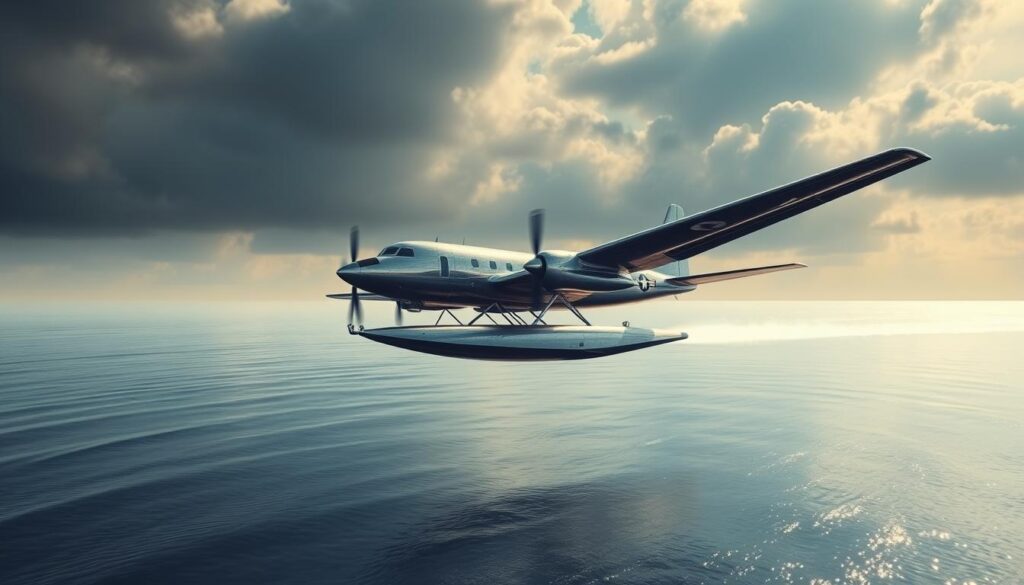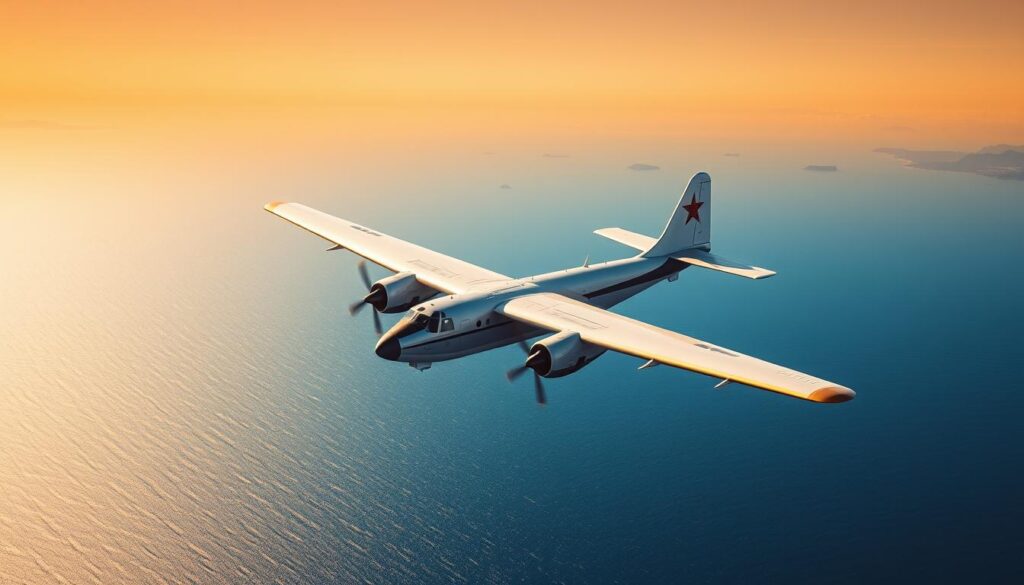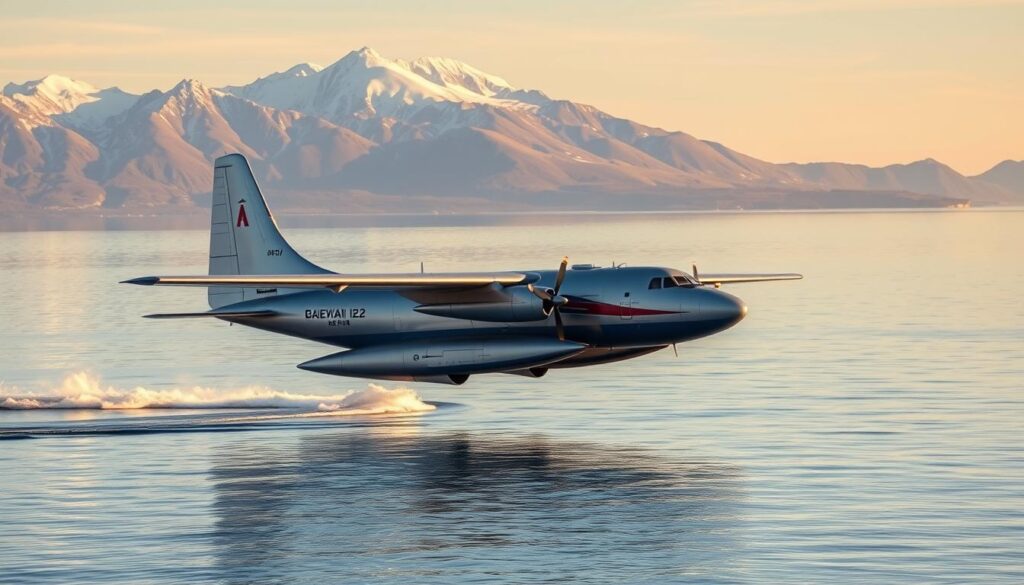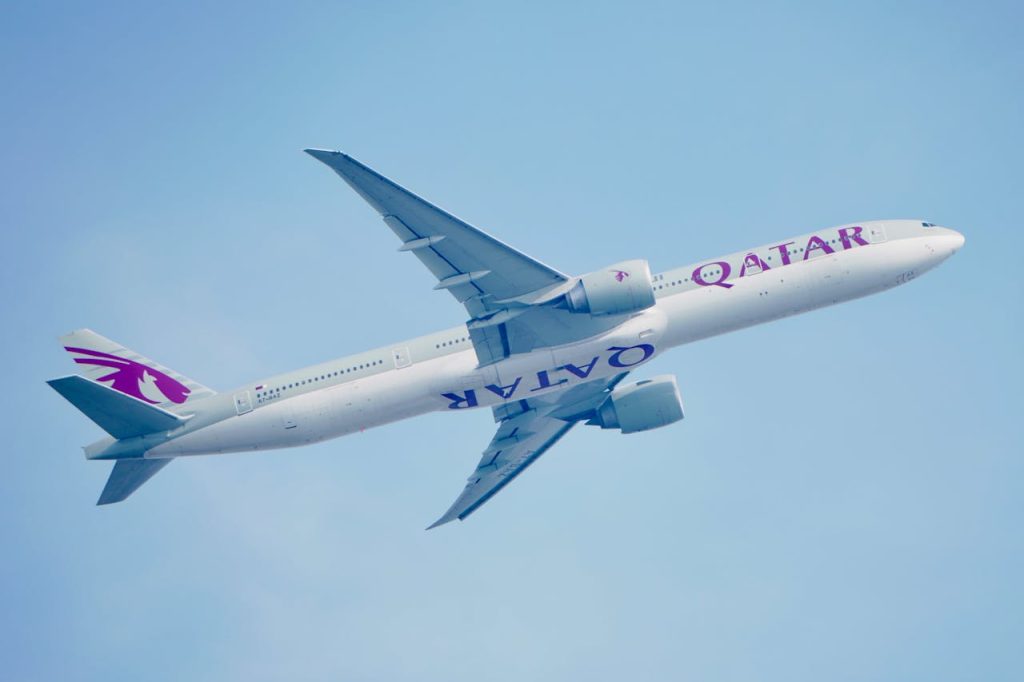Did you know about the BERIEV Be-12 Tchaika? It’s a big deal in Soviet aviation. This special plane can fly up to 3,000 kilometers. It came out in the late 1950s. It was really good at watching over the sea and fighting submarines. The Be-12 was built really smart. It could do lots of things like looking around and saving people. We’re going to learn about its start, what it’s made of, its military jobs, its history, and why it’s so important. This plane shows how creative the Soviets were and how they changed the design of seaplanes. Check out this link for more cool facts.
Key Takeaways
- The BERIEV Be-12 Tchaika was introduced in the late 1950s for maritime patrol and anti-submarine operations.
- It features an impressive maximum range of 3,000 kilometers, enhancing its operational capabilities.
- This Soviet seaplane is known for its innovative gull-wing design, which improves stability.
- The Be-12 contributed significantly to Soviet military aviation, especially during the Cold War.
- Its legacy continues to influence modern amphibious aircraft designs worldwide.
The Origins of the BERIEV Be-12 Tchaika
The origins of Be-12 began in the exciting 1950s. It was a key time for Soviet amphibious aircraft. The Soviet military needed better maritime surveillance. So, they asked the BERIEV Design Bureau for help in 1952. This request led to the creation of a groundbreaking aircraft.
The design of the Be-12 combined old seaplane ideas with new engineering. Engineers and designers worked together. They wanted to make an aircraft that was good on water and in the air. By 1960, their hard work paid off when the Be-12 flew for the first time. It was a big step forward for military aviation.
Design and Development of the Be-12
The Be-12 design development highlights innovation in making aircraft that can land on water. It stands out with a special gull-wing design. This shape helps the plane land smoothly on water and fly better, letting the Be-12 work well in many conditions.
Looking deeper into its creation, we see that engineers did many tests to make sure the Be-12 was up to par. They chose lightweight aluminum alloys to help it carry more and fly farther. This effort led the way for the development of future sea planes.
Thanks to the teamwork at BERIEV, the Be-12 turned into a multifunctional military aircraft. It shows the skill and forward thinking that are key in creating new aircraft that can land on water. Future designs will build on this foundation.
Technical Specifications of the BERIEV Be-12 Tchaika
The BERIEV Be-12 Tchaika is a remarkable example of Soviet engineering skill. It is designed to carry out a range of military tasks. This article looks at its special qualities, such as size, engine power, and weapons. These features make the Be-12 a standout in its class.
Dimensions and Weight
This aircraft is notable for its size and stability. It has a wingspan of 32.4 meters and a length of 23.8 meters. Its balanced design helps it handle well under various conditions. The Be-12 can take off with a max weight of about 35,000 kilograms. This capacity enhances its ability to perform difficult missions.
Engine and Performance
The Be-12 is powered by two Ivchenko AI-20M turboprop engines. It can cruise at about 600 km/h. Its range is roughly 3,000 km, making it great for long missions. This shows the Be-12’s dependability and efficiency, especially as an amphibious aircraft.
Armament and Capabilities
The Be-12 is equipped for a variety of military tasks. It can carry anti-submarine torpedoes and depth charges. These allow it to tackle anti-submarine roles effectively. Also, the aircraft excels in reconnaissance, helping in sea patrols and rescue tasks.
| Feature | Details |
|---|---|
| Wingspan | 32.4 meters |
| Length | 23.8 meters |
| Maximum Takeoff Weight | 35,000 kilograms |
| Engine Type | Ivchenko AI-20M turboprop |
| Cruise Speed | 600 km/h |
| Operational Range | 3,000 km |
| Armament | Anti-submarine torpedoes, depth charges |
Role of the BERIEV Be-12 in the Soviet Military
The BERIEV Be-12 was a key player for the Soviet military, mainly for fighting submarines. It greatly improved the Soviet naval air force’s power. This allowed them to watch over large sea areas.
This plane’s special design and high-tech features let it track down enemy submarines from afar. Its strong capabilities also helped in several rescue missions. This shows how versatile it was for military use.
The Be-12’s military value is huge; it really helped the Soviet Union be strong at sea. In the Cold War, controlling the air over the oceans was very important. The Be-12 played a big part in reaching this aim. Our study shows how vital this aircraft was in watching over the seas and protecting the country.
Operational History of the Be-12
The Be-12 Tchaika was big on the scene at various Soviet Union naval bases. It was key for spying and patrol duties, earning its spot in the Soviet fleet. In the Cold War, the Be-12 was crucial for Soviet navy plans and actions.
First Deployments and Usage
The Be-12 got to work soon after it was introduced. It operated from multiple bases, proving reliable even in tough sea conditions. Its success in spying and reconnaissance showed how vital it was for Soviet naval tactics. These tactics aimed to gather precise info to counter any threats.
Impact in Cold War Naval Operations
In the Cold War, the Be-12 changed how naval warfare was done. As tensions rose, its role in surveillance strengthened the Soviet Union’s strategy. The aircraft was key in patrolling oceans and acted as a deterrent. It showed the strength of Soviet naval strategies during a time of global rivalry.
The Significance of the Be-12 in Soviet Aviation
The BERIEV Be-12 is a huge example of Soviet creativity in the skies. This amphibious plane broke new ground. It could do tasks on both air and sea. The Be-12 was good at changing to fit different places. This showed how flexible Soviet design could be.
The impact of the Be-12 goes beyond just its design. It led to new ideas for water-friendly planes at the BERIEV Design Bureau. These changes helped shape the future of military flying. The Be-12’s history of service shows its lasting importance in the world of flying boats.
Looking at the Be-12, its role in the story of amphibious planes is clear. It represents a high point of Soviet creativity. The Be-12’s design process led to new flying ideas. These continue to influence modern military aircraft worldwide.

Comparing the Be-12 to Other Seaplanes
The BERIEV Be-12 Tchaika holds a special spot in seaplane history. It’s often compared to other important models like the PBY Catalina and the Short Sunderland. Each plane has its unique capabilities for different missions. But, the Be-12 shows some interesting differences.
The PBY Catalina was famous for long-range scouting in World War II. It was great at maritime patrols and search-and-rescue missions. The Short Sunderland was known for fighting submarines, with equipment to track enemy subs.
The Be-12 is different because it can go from water to land smoothly. This made it very useful during the Cold War, especially against submarines. Its design focuses on functionality, making it important for defending the sea.
When we look at these planes, the Be-12’s design really helped in tough times. By comparing them, we learn how these planes met the challenges of their times.
The BERIEV Design Bureau: Innovations and Influence
The BERIEV Design Bureau leads in aviation innovation, especially with amphibious aircraft. Our work has led to important designs that mix function and versatility well. Examples like the Be-12 Tchaika, the BE-200, and the BE-103 highlight our dedication to improving these aircraft.
Years of research and engineering have expanded amphibious aircraft’s capabilities. Our designs have become industry benchmarks and inspired future aviation experts. The Bureau’s work inspires people worldwide to explore and apply the amphibious aircraft concept in various ways.
| Aircraft Model | Year of First Flight | Primary Function | Notable Features |
|---|---|---|---|
| Be-12 Tchaika | 1960 | Anti-Submarine Warfare | Twin-engine, amphibious capabilities |
| BE-200 | 1999 | Firefighting/Transport | Versatile multi-role design, high adaptability |
| BE-103 | 2001 | Passenger Transport | Economical, small-sized amphibious aircraft |
Our designs are always evolving, showing our deep involvement in aviation challenges. We aim to meet the needs of amphibious operations across different settings. Our innovations keep us leading in the development of amphibious aircraft.
Legacy of the BERIEV Be-12 Tchaika
The Be-12’s story is an important part of aviation’s past. It stands out for its great capabilities and new ideas. This sea plane led the way for later generations with its flexible use in water-related tasks. It helped shape the future of sea plane design.
The Be-12 was more than a military tool. It also changed how planes are designed for different roles. Its design showed how planes could do many tasks. This idea helped create new planes that work well in lots of places.
The Be-12 also made waves in civilian flying. It set standards for measuring how well planes perform and how adaptable they are. Its impact lasts to this day, making it a key part of both the past and present in flying.

Modern Influence of the Be-12 on Amphibious Aircraft
The Beriev Be-12 Tchaika has deeply influenced today’s amphibious aircraft. Its design principles still impact modern aviation. Today’s designs focus on versatility, efficiency, and high-tech solutions because of the Be-12.
The BE-200 is a prime example, showing the Be-12’s lasting effect. It blends eco-friendly engines with advanced navigation to meet current needs. This evolution shows a significant shift towards better performance and less environmental harm.
Looking at today’s amphibious aircraft, the Be-12’s legacy is clear. Its focus on multiple roles shapes new designs and ways of operation. The skills in buoyancy, aerodynamics, and tech use today honor the Be-12’s innovative legacy.
The BERIEV Be-12 Tchaika in Popular Culture
The BERIEV Be-12 Tchaika is more than just a plane; it has become an icon. Over the years, it has caught the eye of many, beyond just aviation fans. Many documentaries about Soviet aviation have featured the Be-12.
They show its cool design and important role during the Cold War. In films and video games, the Be-12 helps viewers learn about military planes. It shows the plane’s skills in spotting submarines and in sea patrols. This shows how the Be-12 helps people understand history and military ideas today.
These stories do more than just praise the Be-12’s design. They make us think about what it means to use technology in war. The Be-12’s story continues to be told, showing how tech, history, and what we think about them are linked.
| Medium | Example | Impact on Audience |
|---|---|---|
| Aviation Documentaries | Soviet Seaplanes: A Legacy | Informed insight into Soviet military technology |
| Films | Mission: Impossible – Rogue Nation | Showcased military aircraft in a thrilling narrative |
| Video Games | War Thunder | Immersive experience of piloting the Be-12 |
Conclusion
The BERIEV Be-12 Tchaika holds a special place in Soviet aviation history. This aircraft was built to meet military needs of its era. It brought new engineering ideas that focused on flexibility, dependability, and how well it performed.
Its unique role as an amphibious aircraft was groundbreaking, showing the power of specialized designs. This helped improve how operations are carried out in various settings.
Talking about the Be-12 is not just looking back; it’s a step towards understanding the future of amphibious planes. The design innovations it brought to the table have influenced modern aircraft design. These changes show how learning from the past shapes the future of flying.
In analyzing its use, we see a blend of new ideas and practical use that’s still important today.
The Be-12’s lasting impact is a tribute to Soviet aviation’s creativity and determination to break new ground. Studying its achievements helps us learn from history and dream up new advances in aviation. To sum it up, the Be-12 encourages both a look back and a desire to push further in aircraft design.


